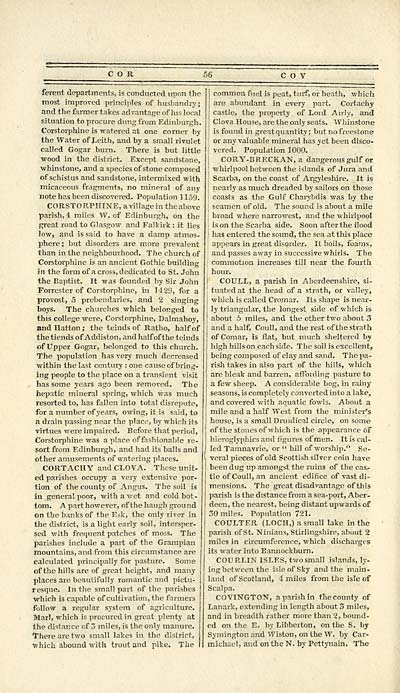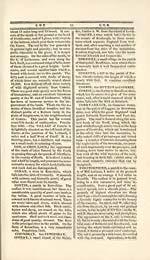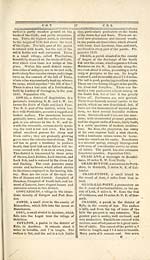Gazetteer of Scotland
(58) Page 56
Download files
Complete book:
Individual page:
Thumbnail gallery: Grid view | List view

COR 56
ferent departments, is conducted upon the
most improved principles of husbandry,;
and the farmer takes advantage of his local
situation to procure dung from Edinburgh.
Corstorphine is watered at one corner by
the Water of Leith, and by a small rivulet
called Gogar burn. There is but little
wood in the district. Except sandstone,
whinstone, and a species of stone composed
of schistus and sandstone, intermixed with
micaceous fragments, no mineral of any
note has been discovered. Population 1 159.
CORSTORPHINE, avillagein the above
parish, 4 miles W. of Edinburgh, on the
great road to Glasgow and Falkirk : it lies
low, and is said to have a damp atmos-
phere ; but disorders are more prevalent
than in the neighbourhood. The church of
Corstorphine is an ancient Gothic building
in the form of across, dedicated to St. John
the Baptist. It was founded by Sir John
Forrester of Corstorphine, in 1429, for a
provost, 5 prebendaries, and 2 singing
boys. The churches which belonged to
this college were, Corstorphine, Dalmahoy,
andHatton; the teinds of Ratbo, half of
thetiends of Addiston, and half of the teinds
of Upper Gogar, belonged to this church.
The population has very much decreased
within the last century : one cause of bring,
ing people to the place on a transient visit
has some years ago been removed. The
hepatic mineral spring, which was much
resorted to, has fallen into total disrepute,
for a number of years, owing, it is said, to
a drain passing near the place, by which its
virtues were impaired. Before that period,
Corstorphine was a place of fashionable re-
sort from Edinburgh, and had its balls and
other amusements of watering places.
CORTACHY and CLOVA. These unit-
ed parishes occupy a very extensive por-
tion of the county of Angus. The soil is
in general poor, with a wet and cold bot-
tom. A part however, of the haugh ground
on the banks of the Esk, the only river in
the district, is a light early soil, intersper-
sed with frequent patches of moss. The
parishes include a part of the Grampian
mountains, and from this circumstance are
calculated principally for pasture. Some
of the hills are of great height, and many
places are beautifully romantic and pictu-
resque. In the small part of the parishes
which is capable of cultivation, the farmers
follow a regular system of agriculture.
Marl, which is procured in great plenty at
the distance of 3 miles, is the only manure.
There are two small lakes in the district,
which abound with trout and pike. The
CO V
common fuel is peat, turf, or heath, which
are abundant in every part. Cortachy
castle, the property of Lord Airly, and
Clova House, are the only seats. Whinstone
is found in great quantity; but no freestone
or any valuable mineral has yet been disco-
vered. Population 1000.
CORY-BRECKAN, a dangerous gulf or
whirlpool between the islands of Jura and
Scarba, on the coast of Argyleshire. It is
nearly as much dreaded by sailors on those
coasts as the Gulf Charybdis was by the
seamen of old. The sound is about a mile
broad where narrowest, and the whirlpool
is on the Scarba side. Soon after the flood
| has entered the sound, the sea at this place
appears in great disorder. It boils, foams,
and passes away in successive whirls. The
commotion increases till near the fourth
hour.
COULL, a parish in Aberdeenshire, si-
tuated at the head of a strath, or valley,
j which is called Cromar. Its shape is near-
ly triangular, the longest side of which is
about 5 miles, and the other two about 3
and a half, Coull, and the rest of the strath
of Comar, is flat, but much sheltered by
high hills on each side. The soil is excellent,
being composed of clay and sand. The pa-
rish takes in also part of the hills, which
are bleak and barren, affording pasture to
a few sheep. A considerable bog, in rainy
seasons, is completely converted into a lake,
and covered with aquatic fowls. About a
mile and a half West from the minister's
house, is a small Druidical circle, on some
of the stones of which is the appearance of
hieroglyphics and figures of men. It is cal-
led Tamnavrie, or " hill of worship." Se-
veral pieces of old Scottish silver coin have
been dug up amongst the ruins of the cas-
tle of Coull, an ancient edifice of vast di-
mensions. The great disadvantage of this
parish is the distance from a sea-port, Aber-
deen, the nearest, being distant upwards of
30 miles. Population 721.
COULTER (LOCH,) a small lake in the
parish of St. Ninians, Stirlingshire, about 2
miles in circumference, which discharges
its water into Bannockburo.
COUP-LIN ISLES, two small islands, ly-
ing between the isle of Sky and the main-
land of Scotland, 4 miles from the isle of
Scalpa.
COVINGTON, a parish in the county of
Lanark, extending in length about 3 miles,
and in breadth rather more than 2, bound-
ed on the E. by Libberton, on the S. by
Symington and Wiston, on the W. by Car-
michael, and on the N. by Pettynain. The
ferent departments, is conducted upon the
most improved principles of husbandry,;
and the farmer takes advantage of his local
situation to procure dung from Edinburgh.
Corstorphine is watered at one corner by
the Water of Leith, and by a small rivulet
called Gogar burn. There is but little
wood in the district. Except sandstone,
whinstone, and a species of stone composed
of schistus and sandstone, intermixed with
micaceous fragments, no mineral of any
note has been discovered. Population 1 159.
CORSTORPHINE, avillagein the above
parish, 4 miles W. of Edinburgh, on the
great road to Glasgow and Falkirk : it lies
low, and is said to have a damp atmos-
phere ; but disorders are more prevalent
than in the neighbourhood. The church of
Corstorphine is an ancient Gothic building
in the form of across, dedicated to St. John
the Baptist. It was founded by Sir John
Forrester of Corstorphine, in 1429, for a
provost, 5 prebendaries, and 2 singing
boys. The churches which belonged to
this college were, Corstorphine, Dalmahoy,
andHatton; the teinds of Ratbo, half of
thetiends of Addiston, and half of the teinds
of Upper Gogar, belonged to this church.
The population has very much decreased
within the last century : one cause of bring,
ing people to the place on a transient visit
has some years ago been removed. The
hepatic mineral spring, which was much
resorted to, has fallen into total disrepute,
for a number of years, owing, it is said, to
a drain passing near the place, by which its
virtues were impaired. Before that period,
Corstorphine was a place of fashionable re-
sort from Edinburgh, and had its balls and
other amusements of watering places.
CORTACHY and CLOVA. These unit-
ed parishes occupy a very extensive por-
tion of the county of Angus. The soil is
in general poor, with a wet and cold bot-
tom. A part however, of the haugh ground
on the banks of the Esk, the only river in
the district, is a light early soil, intersper-
sed with frequent patches of moss. The
parishes include a part of the Grampian
mountains, and from this circumstance are
calculated principally for pasture. Some
of the hills are of great height, and many
places are beautifully romantic and pictu-
resque. In the small part of the parishes
which is capable of cultivation, the farmers
follow a regular system of agriculture.
Marl, which is procured in great plenty at
the distance of 3 miles, is the only manure.
There are two small lakes in the district,
which abound with trout and pike. The
CO V
common fuel is peat, turf, or heath, which
are abundant in every part. Cortachy
castle, the property of Lord Airly, and
Clova House, are the only seats. Whinstone
is found in great quantity; but no freestone
or any valuable mineral has yet been disco-
vered. Population 1000.
CORY-BRECKAN, a dangerous gulf or
whirlpool between the islands of Jura and
Scarba, on the coast of Argyleshire. It is
nearly as much dreaded by sailors on those
coasts as the Gulf Charybdis was by the
seamen of old. The sound is about a mile
broad where narrowest, and the whirlpool
is on the Scarba side. Soon after the flood
| has entered the sound, the sea at this place
appears in great disorder. It boils, foams,
and passes away in successive whirls. The
commotion increases till near the fourth
hour.
COULL, a parish in Aberdeenshire, si-
tuated at the head of a strath, or valley,
j which is called Cromar. Its shape is near-
ly triangular, the longest side of which is
about 5 miles, and the other two about 3
and a half, Coull, and the rest of the strath
of Comar, is flat, but much sheltered by
high hills on each side. The soil is excellent,
being composed of clay and sand. The pa-
rish takes in also part of the hills, which
are bleak and barren, affording pasture to
a few sheep. A considerable bog, in rainy
seasons, is completely converted into a lake,
and covered with aquatic fowls. About a
mile and a half West from the minister's
house, is a small Druidical circle, on some
of the stones of which is the appearance of
hieroglyphics and figures of men. It is cal-
led Tamnavrie, or " hill of worship." Se-
veral pieces of old Scottish silver coin have
been dug up amongst the ruins of the cas-
tle of Coull, an ancient edifice of vast di-
mensions. The great disadvantage of this
parish is the distance from a sea-port, Aber-
deen, the nearest, being distant upwards of
30 miles. Population 721.
COULTER (LOCH,) a small lake in the
parish of St. Ninians, Stirlingshire, about 2
miles in circumference, which discharges
its water into Bannockburo.
COUP-LIN ISLES, two small islands, ly-
ing between the isle of Sky and the main-
land of Scotland, 4 miles from the isle of
Scalpa.
COVINGTON, a parish in the county of
Lanark, extending in length about 3 miles,
and in breadth rather more than 2, bound-
ed on the E. by Libberton, on the S. by
Symington and Wiston, on the W. by Car-
michael, and on the N. by Pettynain. The
Set display mode to: Large image | Transcription
Images and transcriptions on this page, including medium image downloads, may be used under the Creative Commons Attribution 4.0 International Licence unless otherwise stated. ![]()
| Gazetteers of Scotland, 1803-1901 > Gazetteer of Scotland > (58) Page 56 |
|---|
| Permanent URL | https://digital.nls.uk/97422390 |
|---|

